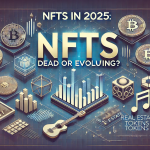Introduction
Geopolitical events have always influenced financial markets, and cryptocurrency is no exception.
From wars and economic sanctions to trade tensions and banking restrictions, global conflicts are reshaping how Bitcoin and altcoins are used.
In 2025, crypto has become a key financial tool for nations, businesses, and individuals navigating economic instability.
How Geopolitical Conflicts Affect Crypto Markets
During global conflicts, traditional banking systems face restrictions, prompting increased use of Bitcoin and stablecoins.
Sanctions imposed on countries like Russia and Iran have forced businesses to turn to crypto for cross-border payments.
Nations experiencing inflation, such as Argentina and Turkey, are seeing Bitcoin adoption surge as a store of value.
Bitcoin as a Safe-Haven Asset During Global Tensions
Historically, investors have turned to gold during times of uncertainty, but Bitcoin is now emerging as a digital alternative.
When geopolitical tensions rise, Bitcoin often sees price spikes as investors move away from fiat currencies.
In 2025, Bitcoin ETFs and institutional investors are reinforcing BTC’s position as “digital gold”.
Crypto Sanctions and Their Impact on Global Trade
Governments use sanctions to restrict a country’s access to the global financial system.
Crypto allows sanctioned entities to circumvent restrictions, making it a double-edged sword for regulators.
Regulators are increasing their focus on blockchain monitoring tools to track illicit transactions.
How War and Conflict Drive Crypto Adoption
Ukraine’s use of crypto donations during the 2022 war with Russia set a precedent for future conflicts.
Now, in 2025, humanitarian organizations are relying on Bitcoin and Ethereum for fast, censorship-resistant aid distribution.
Displaced populations and refugees are using stablecoins like USDC to preserve wealth when banking access is lost.
Government Reactions: Regulation vs. Adoption
Some governments view crypto as a threat, tightening restrictions on its use in conflict zones.
Others, like El Salvador, have embraced Bitcoin as a hedge against financial instability.
Central banks are working on CBDCs (Central Bank Digital Currencies) as a controlled alternative to decentralized assets.
China, the U.S., and the Battle for Crypto Dominance
China continues to push its digital yuan, competing with Bitcoin in international trade.
The U.S. is balancing regulation and innovation, allowing Bitcoin ETFs while increasing scrutiny on stablecoins.
The competition between these two global powers will shape crypto’s role in global finance for years to come.
Altcoins Benefiting from Global Conflicts
Monero (XMR): Privacy coin usage rises due to surveillance-heavy environments.
Ethereum (ETH): Smart contracts enable decentralized finance solutions in economically unstable regions.
Tether (USDT) & USDC: Stablecoins remain the top choice for cross-border transactions in crisis situations.
Crypto’s Role in Decentralized Finance (DeFi) During Global Crises
Decentralized exchanges (DEXs) and DeFi platforms offer financial independence in regions with banking restrictions.
Lending protocols like Aave and MakerDAO provide crypto-backed loans for businesses in struggling economies.
In authoritarian regimes, citizens use DeFi tools to escape financial censorship.
Future of Crypto in Geopolitics
As conflicts and economic instability continue, Bitcoin’s role as a borderless, censorship-resistant currency will expand.
Governments will likely increase blockchain surveillance while exploring their own digital currencies.
The battle between centralized control and decentralized financial freedom will shape crypto’s future in global politics.
Conclusion
Cryptocurrency is no longer just an investment asset—it is now a key player in global geopolitics.
From financial warfare to economic survival, Bitcoin and altcoins are transforming how people and nations interact financially.
As the world becomes more uncertain, crypto’s role in shaping global finance will only continue to grow.











